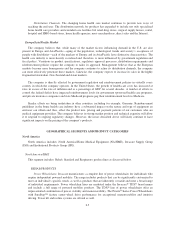Invacare 2008 Annual Report Download - page 21
Download and view the complete annual report
Please find page 21 of the 2008 Invacare annual report below. You can navigate through the pages in the report by either clicking on the pages listed below, or by using the keyword search tool below to find specific information within the annual report.The company occasionally sponsors clinical studies, usually involving its respiratory or sleep products.
These studies have historically been non-significant risk studies with human subjects. Such studies, their
protocols, participant criteria and all results are registered in the Clinical Registry managed by the National
Institutes of Health and available to the public via the Internet.
Although there are a number of reimbursement related issues in most of the countries in which Invacare
competes, the issues of primary importance are currently in the United States. There are two critical
reimbursement issues for the company: the Centers for Medicare and Medicaid Services (CMS) implementation
of National Competitive Bidding (NCB) which Congress delayed last year for 18 to 24 months and changes to
Medicare reimbursement payments for home oxygen mandated by the Deficit Reduction Act.
Effective January, 2009, CMS announced Medicare reimbursement cuts of 9.5% for those product
categories which had been included in phase one of the now delayed NCB program. However, it is expected that
CMS will continue its implementation of NCB in 2009 and thereafter.
In addition to the 9.5% reduction in oxygen reimbursement from Medicare, the Deficit Reduction Act’s
thirty-six month limit on rental payments for home oxygen went into effect January 1, 2009. CMS has clarified
that payments do restart after sixty months of a patient’s usage of oxygen.
Although these reductions in Medicare payments are not beneficial to the home care industry, the company
believes that it can still grow and thrive in this environment. No significant cost-of-living adjustments have been
made over the last few years to the reimbursement and payment amounts permitted under Medicare with respect
to the company’s products, but the company will continue to try to respond with improved productivity to
address the lack of support from Congress. In addition, the company’s new respiratory products (for example, the
low cost HomeFill®oxygen delivery system) can help offset the Medicare reimbursement cuts to the home care
provider. The company will continue to focus on developing products that help the provider improve
profitability. Additionally, the company continues to focus on low-cost country sourcing and/or manufacturing to
help ensure that the company is one of the lowest cost manufacturers and distributors to the home care provider.
BACKLOG
The company generally manufactures most of its products to meet near-term demands by shipping from
stock or by building to order based on the specialty nature of certain products. Therefore, the company does not
have substantial backlog of orders of any particular product nor does it believe that backlog is a significant factor
for its business.
EMPLOYEES
As of December 31, 2008, the company had approximately 6,100 employees.
FOREIGN OPERATIONS AND EXPORT SALES
The company also markets its products for export to other foreign countries. In 2008, the company had
product sales in over 80 countries worldwide. For information relating to net sales, operating income and
identifiable assets of the company’s foreign operations, see Business Segments in the Notes to the Consolidated
Financial Statements.
I-15
























